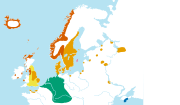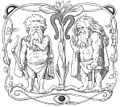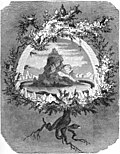In Germanic paganism, a seeress is a woman said to have the ability to foretell future events and perform sorcery. They are also referred to with many...
85 KB (11,137 words) - 07:14, 3 November 2024
Continental Germanic mythology. It was a key element of Germanic paganism. As the Germanic languages developed from Proto-Indo-European language, Germanic mythology...
9 KB (973 words) - 19:50, 30 July 2024
mention the seeress prophesying from a raised platform, while Eiríks saga rauða also mentions the use of a wand. Some insight into Germanic religion can...
128 KB (15,974 words) - 22:17, 7 November 2024
Γάννα) was a Germanic seeress (also called priestess), of the Semnoni tribe, who succeeded the seeress Veleda as the leader of a Germanic alliance in rebellion...
12 KB (1,409 words) - 07:56, 27 October 2024
Poetic Edda (redirect from Germanic Eddas)
and Legend. Völuspá (Wise-woman's prophecy, The Prophecy of the Seeress, The Seeress's Prophecy) Hávamál (The Ballad of the High One, The Sayings of Hár...
26 KB (2,671 words) - 07:06, 4 October 2024
Gambara is a Germanic wise woman (also called priestess or seeress) who appears in several sources from the 8th to 12th centuries. The legend is about...
29 KB (3,956 words) - 22:58, 9 November 2024
Old Norse religion (redirect from North Germanic religion)
of Germanic religion which developed during the Proto-Norse period, when the North Germanic peoples separated into a distinct branch of the Germanic peoples...
104 KB (13,197 words) - 15:57, 5 October 2024
Edda poem Völuspá, the seeress reciting the poem states that Hœnir, Lóðurr and Odin once found Ask and Embla on land. The seeress says that the two were...
13 KB (1,544 words) - 20:27, 7 November 2024
Völuspá (redirect from The Prophecy of the Seeress)
(also Vǫluspá, Vǫlospá, or Vǫluspǫ́; Old Norse: 'Prophecy of the völva, a seeress') is the best known poem of the Poetic Edda. It dates back to the tenth...
14 KB (1,625 words) - 17:59, 16 November 2024
Crystal gazing Séance Secret Chiefs Seer stone (Latter Day Saints) Seeress (Germanic) Seidr (Old Norse) Selkie (Celtic & Norse) Servitor (chaos magic)...
12 KB (1,371 words) - 01:14, 4 October 2024
the Hebrides and the Northern Isles), Greenland, and Canada. Their North Germanic language, Old Norse, became the precursor to present-day Scandinavian languages...
153 KB (18,461 words) - 20:15, 15 November 2024
Norsemen (category North Germanic peoples)
North Germanic linguistic group of the Early Middle Ages, during which they spoke the Old Norse language. The language belongs to the North Germanic branch...
25 KB (2,903 words) - 20:20, 1 November 2024
that became known as Normandy, they originally spoke Old Norse, a North Germanic language. Over time, they came to live among the local Gallo-Romance-speaking...
74 KB (8,554 words) - 19:26, 6 November 2024
Albruna (category Articles with text in Germanic languages)
Aurinia or Albrinia are some of the forms of the name of a probable Germanic seeress who would have lived in the late 1st century BC or in the early 1st...
24 KB (3,200 words) - 17:27, 16 June 2024
Old Norse (category Articles containing Proto-Germanic-language text)
as Old Nordic, or Old Scandinavian, was a stage of development of North Germanic dialects before their final divergence into separate Nordic languages....
112 KB (8,843 words) - 17:12, 31 October 2024
Runic magic (redirect from Germanic runic astrology)
is the case from the earliest epigraphic evidence of the Roman to the Germanic Iron Age, with non-linguistic inscriptions and the alu word. An erilaz...
23 KB (3,004 words) - 17:03, 28 August 2024
Dwarf (folklore) (redirect from Dwarf (Germanic mythology))
A dwarf (pl. dwarfs or dwarves) is a type of supernatural being in Germanic folklore. Accounts of dwarfs vary significantly throughout history; however...
40 KB (5,092 words) - 06:55, 27 October 2024
Norse clans (category Family in early Germanic culture)
Gothi Early Germanic calendars Runic magic Seeress (Germanic) Galdr Death in Norse paganism Society Berserker Earl Ergi Erilaz Félag Germanic kingship Hird...
3 KB (323 words) - 07:18, 28 August 2024
Volva may refer to: Völva, one of various Old Norse terms for a North Germanic seeress Volva (gastropod), a genus of sea snails Volva (mycology), a cup-like...
427 bytes (88 words) - 03:00, 15 February 2020
Veleda (category 1st-century Germanic people)
Veleda (fl. AD 69–84) was seeress of the Bructeri, a Germanic people who achieved some prominence during the Batavian rebellion of AD 69–70, headed by...
8 KB (1,037 words) - 16:34, 9 August 2024
Woman of the Chatti (redirect from Chattian seeress)
of the Chatti (Latin: Chatta mulier), or the Chattian seeress, is an alleged Germanic seeress of the Chattian tribe who according to Suetonius prophesied...
8 KB (984 words) - 07:43, 21 October 2024
Christianization of Scandinavia (category Germanic Christianity)
irreligiosity. Christianization of Lithuania Christianization of Kievan Rus' Germanic Christianity Heimskringla – A mediaeval work that relates the lives of...
38 KB (4,972 words) - 04:14, 21 November 2024
Canterbury charm (category Sources on Germanic paganism)
Gothi Early Germanic calendars Runic magic Seeress (Germanic) Galdr Death in Norse paganism Society Berserker Earl Ergi Erilaz Félag Germanic kingship Hird...
2 KB (313 words) - 09:42, 28 October 2024
List of pagans (section Germanic)
Horapollo, 5th-century Egyptian pagan writer Historic Germanic pagans: Albruna, Germanic seeress, prophetess, soothsayer Aoric, Gothic pagan Arbogast (died...
9 KB (1,181 words) - 17:01, 19 January 2024
Jötunn (category Articles containing Proto-Germanic-language text)
/ˈjɔːtʊn/; or, in Old English, eoten, plural eotenas) is a type of being in Germanic mythology. In Norse mythology, they are often contrasted with gods (the...
37 KB (4,006 words) - 13:38, 10 November 2024
Waluburg (category Articles with text in Germanic languages)
'magic staff protection' (Greek: Βαλουβουργ), was a second century Germanic seeress (sorceress, priestess) from the Semnonian tribe whose existence was...
19 KB (2,102 words) - 06:38, 27 October 2024
Gróa (category Germanic seeresses)
Norse mythology, Gróa (possibly from Old Norse "growing") is a völva (seeress) and practitioner of seiðr. She is the wife of Aurvandil the Bold. Groa...
3 KB (259 words) - 17:05, 8 November 2024
Cimbrian seeresses (category Articles with text in Germanic languages)
little evidence of Germanic priestesses from the time of Tacitus to the era of conversion (Njáls saga). If the functions of seeress and priestess are not...
35 KB (4,659 words) - 23:47, 18 November 2024
Yggdrasil (category Trees in Germanic paganism)
the second stanza of the Poetic Edda poem Völuspá, the völva (a shamanic seeress) reciting the poem to the god Odin says that she remembers far back to...
26 KB (3,364 words) - 09:56, 20 November 2024
Seiðr (category Germanic paganism)
craft. A woman practicing seiðr would sometimes be called völva, meaning seeress. She would also sometimes be described as spá-kona or seið-kona, meaning...
22 KB (2,403 words) - 04:44, 24 October 2024





















